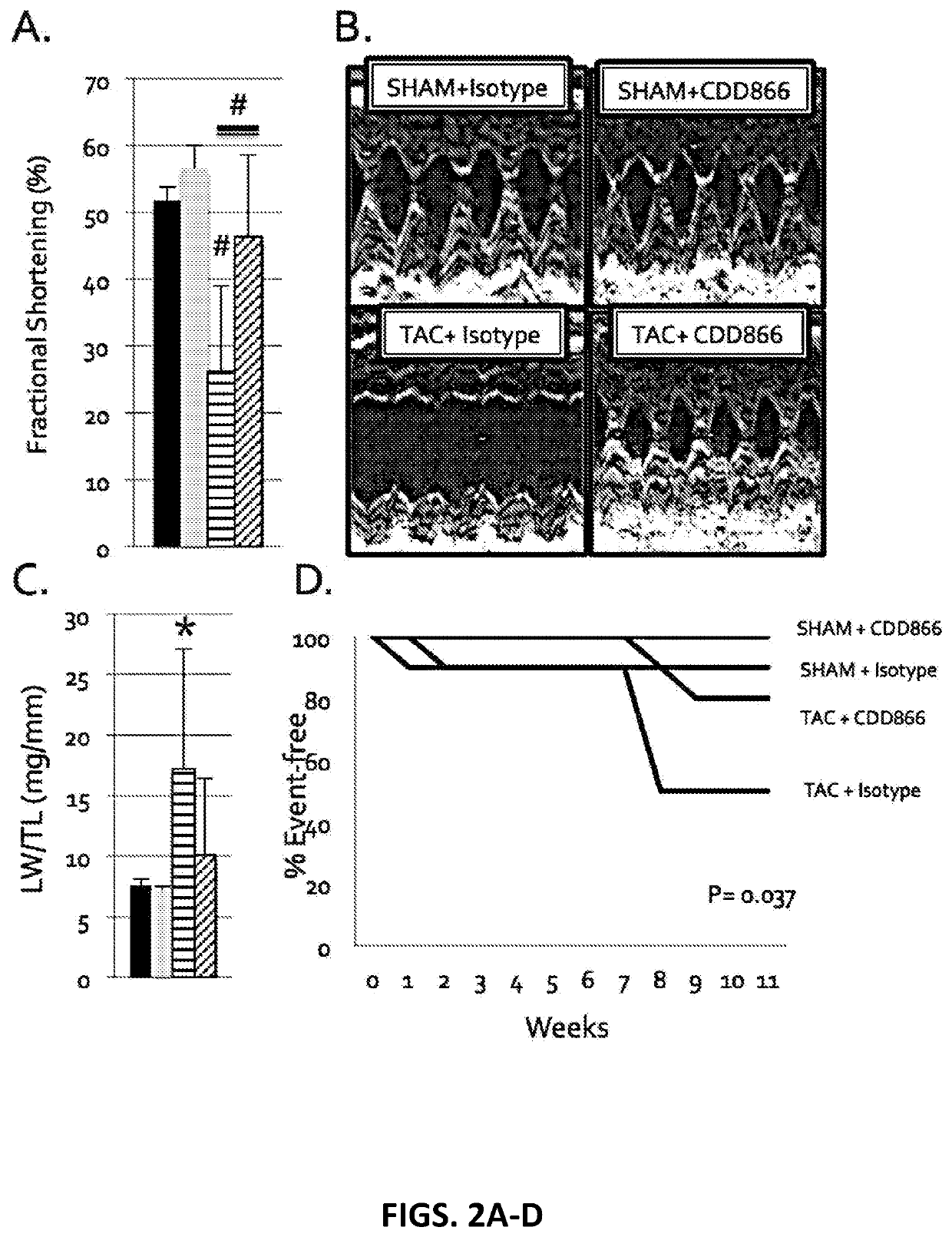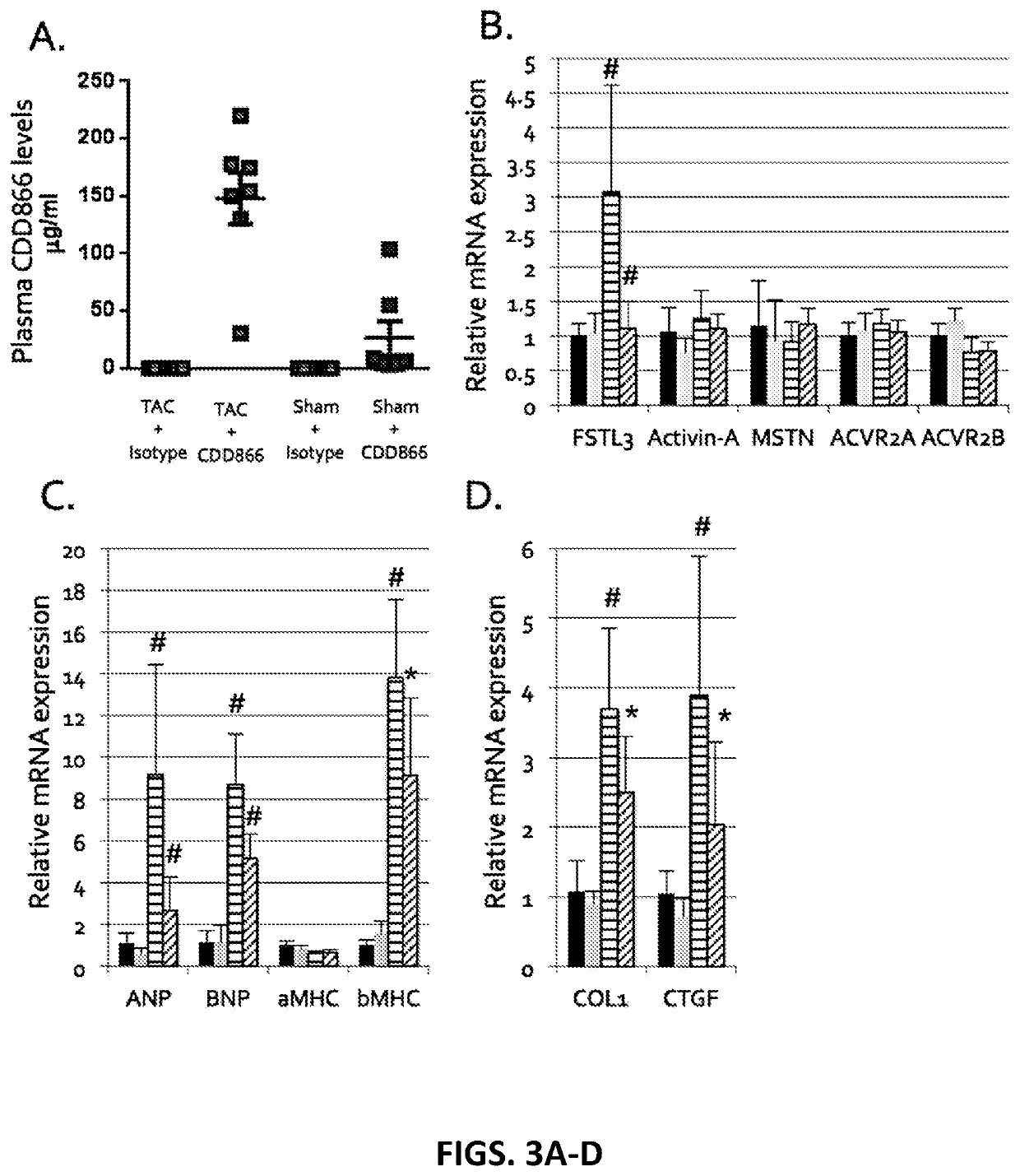Methods for treating and/or reducing the likelihood of heart failure by administering anti-activin receptor type II (anti-ActRII) antibody
a technology of activin receptor and anti-actrii, which is applied in the direction of cardiovascular disorders, peptides, drug compositions, etc., can solve the problems of insufficient systemic perfusion to meet the body's metabolic demands, similar phenotypes of clinical heart failure, and functional performance, so as to reduce the ejection fraction and treat and/or prevent heart failure
- Summary
- Abstract
- Description
- Claims
- Application Information
AI Technical Summary
Problems solved by technology
Method used
Image
Examples
example 1
ntion Study
Materials and Methods:
[0503]This study tests whether CDD866 prevents the development of cardiac dysfunction in an established transverse aortic constriction (TAC) murine model of heart failure. The following 4 groups of 16-week-old male C57BL / 6 mice (n=7-10 / group) are part of the study:[0504]1. SHAM+Isotype Ab[0505]2. SHAM+CDD866 Ab[0506]3. TAC+Isotype Ab[0507]4. TAC+CDD866 Ab
[0508]Antibody is administered subcutaneously (SQ), 20 mg / kg, once a week, with the last dose given <24 h prior to sacrifice.
[0509]Echocardiography is performed every two weeks.
[0510]Primary endpoint: pre-specified endpoint of 11-week post-TAC or % fractional shortening (FS)<20%
Results:
[0511]As shown in FIGS. 1A-1E, CDD866 Ab treatment has minimal cardiac effects in wild-type C57BL / 6 mice. Specifically, as depicted in FIG. 1A, measured plasma levels of CDD866 confirm that drug was administered appropriately. CDD866 does not significantly increase cardiac mass (FIG. 1B). CDD866 decreases myocardial fi...
example 2
ment Study
Materials and Methods:
[0515]This study tests whether CDD866 can rescue animals from heart failure by reversing established cardiac dysfunction in animals subjected to TAC.
[0516]The following 2 groups of 16-week-old male C57BL / 6 mice (n=10 / group) are studied:[0517]TAC+Isotype Ab[0518]TAC+CDD866 Ab
[0519]Antibody treatment is started only after a decrease in % fractional shortening >4 standard deviations.
[0520]Antibody is administered SQ, 20 mg / kg / wk×8 weeks (last dose given <24 h prior to sacrifice)
[0521]Echocardiography is performed every two weeks.
[0522]Primary endpoint: pre-specified endpoint of 8 week treatment or % FS<25%
Results:
[0523]As FIGS. 4A-4D show, CDD866 treatment restores cardiac function and rescues animals from TAC-induced heart failure. Measured CDD866 plasma levels indicate drug administered appropriately in systolic function (FIG. 4A). FIG. 4B graphically depicts the finding that cardiac FSTL3 expression decreases with CDD866 treatment, indicating it effec...
example 3
Timepoint Study
Materials and Methods:
[0528]This study tests whether CDD866 could improve cardiac function in a genetic model of dilated cardiomyopathy (MHCF764L).
[0529]2 groups of 14-24 week-old male MHC F764L+ / −mutant mice are studied:[0530]Isotype Ab (n=3)[0531]CDD866 Ab (n=3)
[0532]The antibody is administered SQ, 20 mg / kg / wk×12 weeks (last dose given [0533]Echocardiography is performed every two weeks (q2wk).[0534]Primary endpoint: pre-specified endpoint of 12 week treatment or % FS<20%
Results:
[0535]CDD866 has minimal cardiac effects in a genetic dilated cardiomyopathy model (although only modest cardiac phenotype at baseline). As graphically depicted in FIG. 8A, CDD866 induces trend toward mildly increased systolic function in MHCF74L mice. FIG. 8B illustrates a trend toward decreased cardiac FSTL3 expression with CDD866 treatment, indicating that it is effectively blocking ActRII-A / B signaling in the heart. As shown in FIG. 8C, no significant difference in pathologic hypertroph...
PUM
| Property | Measurement | Unit |
|---|---|---|
| half life | aaaaa | aaaaa |
| molecular weight | aaaaa | aaaaa |
| molecular weight | aaaaa | aaaaa |
Abstract
Description
Claims
Application Information
 Login to View More
Login to View More - R&D
- Intellectual Property
- Life Sciences
- Materials
- Tech Scout
- Unparalleled Data Quality
- Higher Quality Content
- 60% Fewer Hallucinations
Browse by: Latest US Patents, China's latest patents, Technical Efficacy Thesaurus, Application Domain, Technology Topic, Popular Technical Reports.
© 2025 PatSnap. All rights reserved.Legal|Privacy policy|Modern Slavery Act Transparency Statement|Sitemap|About US| Contact US: help@patsnap.com



